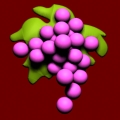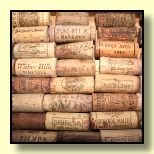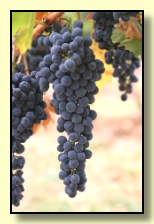|
|
|


Paradox It has been observed that although both the French and Americans have a diet high in saturated fats, smoke cigarettes and don't exercise enough - all high risk factors for cardiovascular disease - the French have a much lower risk of such disease than Americans (less than half). Therefore the term "French Paradox". The difference has been attributed to the consumption of alcohol - particularly red wine. The French consumption of wine is about 60 L per capita per year, compared to the Americans at only 7.7 L. Australians (at 18.1 L) have a cardiovascular disease risk level that falls in between that of the French and the Americans.
The shallow champagne glass ("coupe" or "saucer") is said to have originated with Marie Antoinette - the first ones being fashioned with molds made
from her breasts. Not recommended. 
|
SERVING WINE
Although many rules are made to be broken, there are, nevertheless, basic guidelines as to the most sensible way to serve wines thoughout a meal. Basically they are:
SERVING TEMPERATURE Temperature Converter
RED: Not all reds are the same. Even the finest red can seem dull and heavy if served too warm, and some red wines are at their best slightly chilled. The more tannic the wine, the more it will benefit from being served less cool, and younger, fruitier wines are usually best at a lower temperature. Red wines are normally served chilled between 6°-19°C / 43°-67°F.
WHITE: White wines are normally served chilled between 5°-12°C / 42°-55°F.
ROSÉ: If you're chilling in a hurry, an ice bucket filled with water and ice cubes is more effective than ice alone. Serve only small portions at first, giving the rest of the wine a chance to chill. To warm a wine up, just set it in a bucket of tepid water.
FORTIFIED WINES: Fortified wines such as a Madeira, Muscat, Ports and Sherries are served at 12°-18°C / 55°-65°. WINE GLASSES An elegant and properly shaped glass can greatly enhance the drinking of wine. If you haven't got the "right" glasses, make sure you at least have glasses that are smaller at the rim than across the bowl. This will prevent the bouquet of the wine from escaping. Glasses for white wine usually have a longer stem, so the wine glass can be held without the hand warming the bowl of the glass. Don't overpour. A third to half-full is about right. Now, if you really want to get fussy... Each wine has it's own distinguishing characteristics and glasses should allow the bouquets and aromas to be fully enjoyed. Light wines such as Pinot Noir (red) or a Chenin Blanc (white) need a more closed or narrow opening at the top to keep the aromas in the glass so the "nose" may be fully enjoyed. Heavier wines such as an oaky Chardonnay or Cabernet Sauvignon require a larger opening at the top allowing the aroma to escape a bit as to not be overpowering. Very heavy full bodied wines such as Burgundy or Bordeaux need even larger (16-24 oz.) glasses with a larger opening at the top. In general, light bodied wines need a smaller opening to keep the aromas in and heavy wines need a larger opening so as to not be overpowering.
The champagne flûte: The flute has generally replaced the champagne coupe or saucer, the shape of which could not be worse for allowed carbonation to quickly dissipate.  THE CORK
THE CORK
You uncork a bottle of wine or you're in a restaurant and the waiter/waitress has removed the cork and placed it on the table for your it scrutiny. What do you look for? The cork should be supple, not dried out so that air may have entered. As well, if the cork shows a stain of red wine (only) reaching the top of the cork, it may indicate a faulty seal and therefore a spoiled wine. If the bottom of the cork shows crystallization, the wine may need to be decanted or poured so the crystallizations do not end up in the glass.
NOTES Perhaps the best solution for sealing wines is the synthetic cork. They're more efficient then regular corks in providing a better seal, they don't taint the wines, and they don't break off in the bottle. You can still use your favorite corkscrew, and still enjoy that satisfying "pop" as you liberate it from the bottle neck. DECANTING Decanting both lets the wine "breathe" (just taking the cork out does not expose much of the wine to the air), and separates the wine from sediment. This usually applies to older, red wines - young wines and white wines usually do not have to be decanted. Wines are full of organic things - like yeast and grape skins - and very small particles settle out of the wine over the years after it is bottled. This is a normal and expected occurance, and older red wines, which have more skin contact, usually have more sediment. Nowadays, with modern production and filtering methods, we are not used to seeing much sediment in wine. However, excessive filtering can remove flavour from the wine. The process:
At a certain point air causes more damage than good. Wine can sit in the decanter for 1/2 to 1 hour before drinking. If you let the wine sit out too long, it could warm up too much (not good for flavour) and, as wine + air = vinegar, if exposed to air for over 8 hours, a vinegar taste may begin to overpower the good flavors. For the nervous or unsteady-of-hand, coffee filter paper will effectively separate sediment from liquid. 
Copyright © 2007-2018 WWW.BACCHUSURBANWINERY.COM All rights reserved.
|
|
|
|
 Serving temperature of wine varies depending on the style of wine and your personal preference. Serving a wine that is a bit too cold can reduce it's aroma and flavor. The less expensive wines are usually stored at lower temperatures.
Serving temperature of wine varies depending on the style of wine and your personal preference. Serving a wine that is a bit too cold can reduce it's aroma and flavor. The less expensive wines are usually stored at lower temperatures.